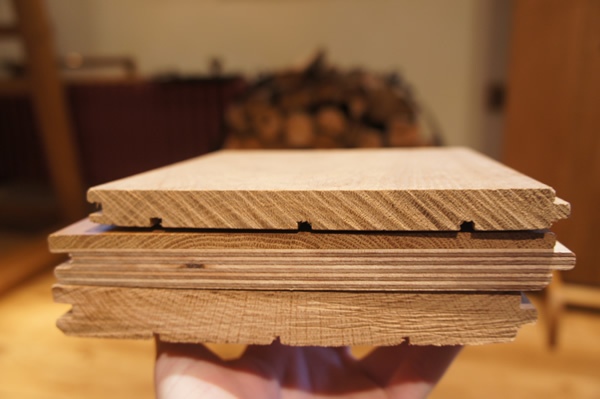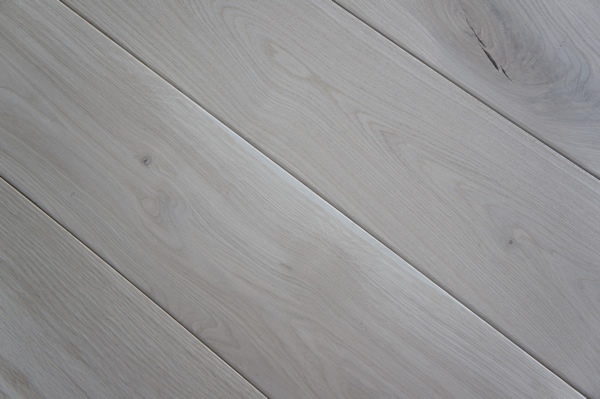Things To Consider When Purchasing Oak Flooring
19th Feb 2014 @ 18:04
When in the process of purchasing oak flooring, you will no doubt come across the number of different options that are available. When looking at any oak floor there are points that should be considered to ensure you get the exact product you require.
Solid Or Engineered Oak Flooring
The first point to consider is whether or not you require solid or engineered oak flooring. This is a hugely important point, as the wrong choice can leave you with problems further down the line.
Solid oak flooring boards are exactly what they say on the tin. They are boards that are 100% made up of oak. Engineered Oak Flooring on the other hand are boards which are made up of a combination of layers. Engineered oak has a top wear layer of solid oak, which is bonded to a ply-board base.
A traditional solid oak floor can be laid over a wooden subfloor or over the top of joists. This is done by screwing or nailing the floor down. Solid oak boards can also be glued down using a flexible adhesive, however we do not recommend glueing a solid oak board which is wider than 120mm.
Engineered oak flooring is very much designed for places where solid oak flooring is not suitable. In areas where the humidity is constantly changing, such as a kitchen or bathroom, an engineered oak floor is often recommended. This is because engineered boards are much less susceptible to changes in humidity.
Engineered boards can be laid using the same methods as solid oak boards, as well as using the floating floor method. Boards wider than 120mm can also be glued down with engineered oak flooring.
For areas where there is underfloor heating, we always recommend choosing engineered oak flooring.

Thickness Of Board
The thickness of the oak floor board is the next point to consider. Here at Peak Oak we have solid oak flooring available in a thickness of 14mm or 20mm. The traditional 20mm solid oak flooring can be laid directly onto joists for use as a stable floor. The 14mm solid oak flooring on the other hand needs to be fitted over some form of wooden subfloor.
Engineered oak flooring is commonly produced in a thickness of 20mm. However often thinner boards are available, such as 15mm. It is worth noting with engineered oak flooring, that a thinner board will compromise on the top wear layer.
Grade Of Oak Flooring
With the above choices made, you can now begin make decisions on the look of the oak flooring. This starts with choosing the grade. The grading of the board decides what it will look like from above and what defines it.
At this step you need to decide whether you want an oak board full of character (knots, cracks, shakes, holes) or a "cleaner" board. With this decision made you can decide how far along the scale you go, so for a characterful board it is a choice of whether you want the complete “roughness” of the barn grade or the slightly more refined character grade. For a cleaner board you could opt for the perfection of a prime board, or the slight character of the select grade.
Traffic Levels
The amount of traffic that is likely to pass over your floor can influence which grade you choose. Oak flooring will scratch, however with the character and barn grades these often go unnoticed and become part of the floor. If you have pets that are likely to scratch the floor, these grades would be recommended.

Lengths Available
The lengths of the boards supplied is a further important point to consider when purchasing oak flooring. Some oak flooring is sold as short as 300mm in length. Once laid these small pieces can often look unsightly. Always check what length of boards are available, the longer the better!
Widths Available
What width you choose can change the whole complexion of your room. What width looks best in a smaller room can often not look as good in larger rooms.
Finish Of The Boards
The finish of the board is probably one of the most important choices you will make when purchasing your oak floor. Oak flooring is supplied in either an unfinished state (requiring a finish once laid) or a prefinished state (ready applied with a finish). With an unfinished floor the possibilities of different finishes is endless, however some prefer the readiness of a prefinished board.
Whatever finish you decide upon, it is important that it is not only to your tastes, but also provides maximum protection. You can see a complete comparison of some of the finishes available on our guide to oak floor finishes.
If you have any further queries on what is available with oak flooring, please give us a call on 01538 304584.




1 Comment
This is great advice, we sell boards for fitting and a lot of our customers do not consider all the options available to them, meaning they end up confused by all our questions.
We are in the process of providing a similar guide on our website :)
Natalie French February 26, 2014 at 4:33pm
Add a comment